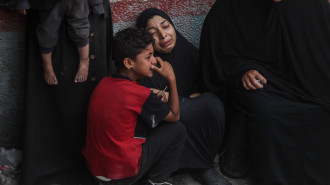
Continued tree cutting in Egypt sparks fury as heatwave hits record highs

Over the past few weeks, Egypt has experienced an intense heatwave with unprecedented temperatures. In Aswan, in southern Egypt, temperatures soared to 49 degrees Celsius.
The Egyptian Meteorological Authority expects the heatwave to continue for several more days and weeks into the summer, attributing this to "the influence of a highly heated air mass and a high-pressure system in the upper atmosphere, which traps the heat near the Earth's surface."
Simultaneously, with the persistent rise in temperatures beyond normal levels in Egypt, the pace of tree and park removals from the streets of Cairo and other cities has accelerated.
These removals are to build bridges, widen paved roads, or even set up kiosks and fast-food outlets, which has sparked anger on social media.
During the online protests, hundreds of thousands of Egyptians posted pictures showing the removal of trees and changes to Cairo's famous squares following their "development," which replaced green spaces with kiosks, fast-food outlets, and cafes.
Why are temperatures rising?
Mohamed Sherif, a meteorology professor at Port Said University in Egypt, explains that rising temperatures are a global issue, impacting most countries because of worsening global warming.
He adds that certain human activities, like air pollution and cutting down trees, can make the heat feel worse. These practices cause the Earth to retain heat longer than usual, especially during summer in Egypt.
A study published in the journal Nature Climate Change in October 2012 found that the average temperature in the Mediterranean region, including Egypt, has risen by 1.4 degrees Celsius since the pre-industrial era.
The study focuses on how climate change affects sustainable development in Mediterranean countries. This represents an increase of 0.4 degrees Celsius above the global average temperature rise, exacerbating environmental problems in the region.
Sherif notes in a statement to The New Arab that the variation in temperatures between some Egyptian cities, despite their close latitudinal proximity, is due to the "local climate" phenomenon.
Additionally, the difference in green cover and water bodies among these cities creates thermal variations, creating a local climate different from nearby rural areas, known as urban heat islands.
An urban heat island is an urban area significantly warmer than its surrounding rural areas. The temperature difference is usually greater at night than during the day and is more noticeable when the wind is weak.
One of the main causes of the urban heat island is the lack of green cover, leading to less solar energy being reflected and more heat being retained by the ground and buildings compared to rural areas.
Cairo's tree massacre
According to a study published in 2022 in the Journal of Engineering and Applied Science, Cairo lost about 910,894 square metres of its green spaces between 2017 and 2020.
In 2020, the per capita share of green spaces in Egypt decreased by 0.3 square metres below the planned average for the same year, which was set at 1 square metre, according to the government's Vision 2030 for development.
The government plan expects the per capita share of urban green spaces to reach 3 square metres by 2030. However, Egypt's Minister of Environment stated in May 2023 that the per capita share of green spaces had reached 1.2 square metres, with a target of 3 square metres by 2030.
The World Health Organization recommends a minimum per capita share of 9 square metres of green space within a 15-minute walk from home.
Environmental expert Tarek Kandil explains that trees act as the lungs of the Earth, absorbing carbon dioxide and releasing oxygen. He believes that areas with trees are 2 to 3 degrees Celsius cooler than areas without trees.
"Trees and areas with large tree cover act as natural air conditioners that cool the heat," Kandil told The New Arab.
He adds that the leaves and branches of urban trees allow only about 10 to 30% of solar radiation to reach the area beneath their shade, with the rest of the solar energy absorbed by the leaves for photosynthesis or reflected into the atmosphere.
Adaptation is the solution
Magdy El-Sayed, a professor of urban planning at Mansoura University, points out that the "Urban Fabric," which includes factories, buildings, paved roads, and complex transportation networks, is responsible for urban heat islands.
He adds to The New Arab that any green cover reduces the temperature of the area where it is planted; thus, removing green cover increases the feeling of heat.
The professor believes that the temperature rise in Egypt is not a local event or related to tree removal but is a global increase accompanied by the rise in greenhouse gases and global warming issues.
He views increasing green spaces on the streets as not the only solution to mitigate the effects of heatwaves but also planting rooftops.
"To achieve thermal comfort, green building materials from the local environment should be used to help cool the interiors of buildings," he believes.
El-Sayed notes that urban planning is the phase where urban green spaces should be designed.
Nevertheless, it is not too late to correct what planners neglected, and strategies should be implemented to adapt, such as increasing green spaces in urban areas, increasing shade, and adding more water fountains in squares using treated water.
Mohammed El-Said is the Science Editor at Daily News Egypt. His work has appeared in Science Magazine, Nature Middle East, Scientific American Arabic Edition, SciDev and other prominent regional and international media outlets
Follow him on X: @MOHAMMED2SAID



 Follow the Middle East's top stories in English at The New Arab on Google News
Follow the Middle East's top stories in English at The New Arab on Google News


